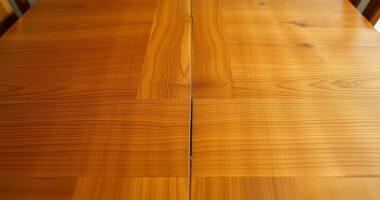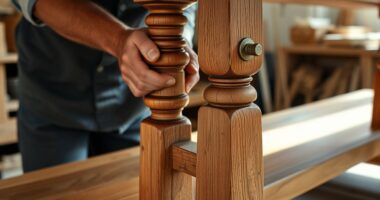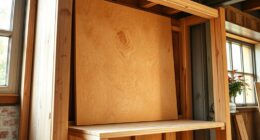To correct warped boards, control moisture by reapplying even humidity with damp cloths or humidifiers to realign the grain. Use clamps with cauls to apply uniform pressure along the entire length of the board, ensuring it remains flat. Lock moisture in by sealing surfaces with finishes like polyurethane or shellac. Patience and proper technique are essential; mastering these steps will help you restore the board’s shape and prevent future warping. Keep going to learn even more effective tips.
Key Takeaways
- Reintroduce moisture evenly using damp cloths or humidifiers to help straighten warped boards.
- Clamp the board flat with appropriate cauls, applying even pressure across the entire surface.
- Support the entire length of the board during clamping to prevent new distortions.
- Leave clamps in place until moisture has fully redistributed and the board has stabilized.
- Combine moisture control with surface sealing or finishing to maintain flatness over time.

Warped boards can be a frustrating obstacle in woodworking projects, but controlling moisture and applying proper clamping techniques can prevent and correct warping effectively. One of the key factors influencing warping is grain orientation. When you select your wood, pay close attention to how the grain runs across the board. Grain that runs parallel to the length of the piece tends to resist warping better than grain that runs across it. Understanding the natural tendencies of the grain helps you choose the best orientation for your project, reducing the risk of future warping. When working with the wood, always keep in mind that uneven moisture content can cause the grain to swell or shrink unevenly, leading to warping. To minimize this, keep your wood in a controlled environment before working on it, and consider drying it properly if it’s been stored in a humid space.
Once you’ve selected the right grain orientation, you’ll want to focus on moisture control during the gluing and finishing process. Applying finishing techniques that seal the surface helps lock in moisture and prevents rapid changes that can cause warping later. For example, you might use a polyurethane or shellac finish, which creates a barrier against humidity fluctuations. Additionally, if your board shows signs of warping, you can try flattening it by reapplying moisture evenly—using a damp cloth or humidifier—and then pressing it flat with clamps. Be patient with this process, as it can take several hours or days for the moisture to evenly distribute and for the board to regain its flatness.
Clamping is another essential element in correcting warped boards. When you clamp your wood, guarantee you’re applying even pressure across the surface. Use cauls—straight pieces of wood placed across the board—to distribute pressure uniformly and prevent creating new distortions. Proper clamping also involves making sure the board is supported along its entire length, especially if it’s markedly warped. After clamping, leave the board undisturbed for an adequate amount of time to allow the moisture to equilibrate and the wood fibers to settle into their new position. Once the board is flat, consider applying a finish that stabilizes the wood, such as a sanding sealer or a penetrating oil, to help maintain its shape and resist future warping caused by moisture changes.
Frequently Asked Questions
How Long Does It Take for a Warped Board to Fully Straighten?
It typically takes a few days to a week for a warped board to fully straighten, depending on grain orientation and moisture content. You should clamp it properly and guarantee even pressure, adjusting as needed. Keep the moisture content balanced by storing the board in a controlled environment. Regularly check the progress, and avoid rushing the process, as patience helps the wood regain its proper shape more effectively.
Can Warped Boards Be Repaired Without Removing the Warp?
You can often repair warped boards without removing the warp by focusing on wood stabilization and moisture regulation. Start by applying controlled moisture to the concave side and then clamp the board securely. This method encourages the wood to reshape gradually. Keep in mind, the process takes time—usually several days—to achieve the best results. Patience and proper moisture management are key to restoring your warped board without complete removal.
What Types of Clamps Are Best for Large Warped Panels?
Like a knight with a trusty sword, you need the right tools for the job. For large warped panels, bar clamps or pipe clamps are best because they provide even pressure across the surface. They’re versatile for clamp application and can handle significant weight, ensuring your board straightens properly. These clamps allow you to apply consistent pressure, helping to restore your panel’s shape without causing further damage.
Is It Possible to Prevent Warping During Initial Drying?
Yes, you can prevent warping during initial drying by using moisture barriers to control how moisture escapes and enters the wood. Proper wood stabilization techniques, like maintaining consistent humidity and temperature, help keep the wood evenly dry. Additionally, stacking boards with spacers ensures good air circulation, reducing uneven drying. This approach minimizes warping, helping your wood stay flat and stable during the drying process.
How Can I Identify the Underlying Cause of Warping?
To identify the cause of warping, start by checking the moisture content of the wood with a moisture meter; uneven readings often lead to warping. Also, observe the wood grain direction—warping usually occurs perpendicular to the grain. If the moisture content is higher on one side or the grain runs unevenly, these are likely culprits. Correcting these issues helps prevent future warping and guarantees stable, flat boards.
Conclusion
To prevent warping, control moisture, monitor humidity, and use proper clamping techniques. To straighten warped boards, apply pressure, adjust clamps, and allow time for drying. To maintain quality, check regularly, adapt methods, and stay patient through the process. By managing moisture, using clamps effectively, and staying attentive, you guarantee your boards stay straight, strong, and true. Keep these steps in mind, and you’ll turn warped wood into perfect, professional results every time.









